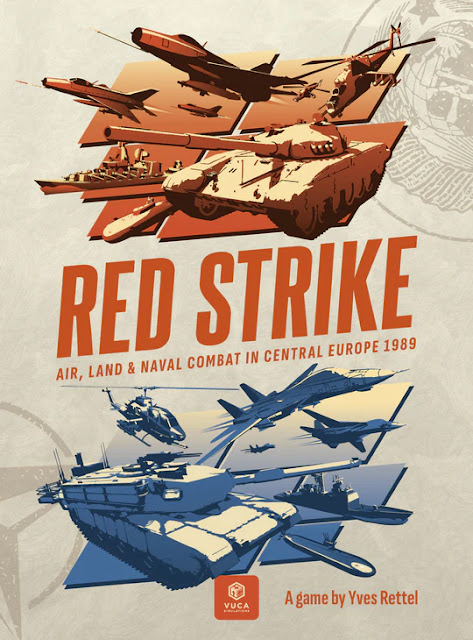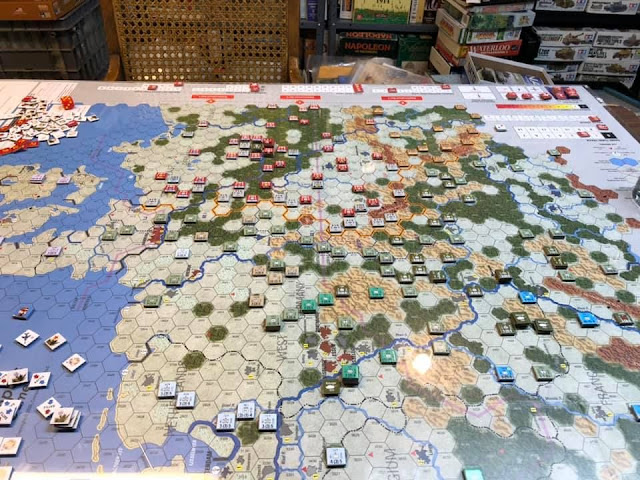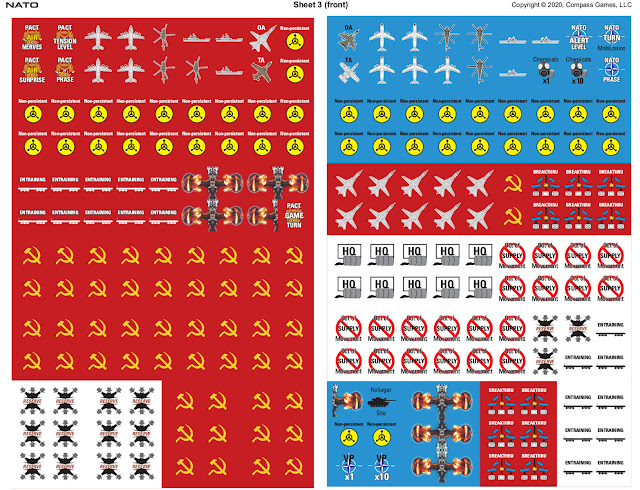Red Strike
Air, Land and Naval Combat in Europe 1989
by
Vuca Simulations
When we last picked up Wolfram von Eschenbach's magnum opus, Parzival was wandering through the forest of other wargames looking for the Grail. According to the tale, he stopped at the castle of Vuca Simulations and spoke to the fisherman. Did Parzival find the Grail or was this just another false lead from Klingsor? Read on to see.
This is from Vuca Simulations about the 'history' of the game:
 |
| The game in some of its glory |
I had thought that Vuca Simulations 1914 Nach Paris was the pinnacle of wargaming in both playing and artwork. Now along comes Red Strike and I have to eat my words. All you have to do is to check out the box. Like all of Vuca Simulations games it is a work of art all by itself. However, the size and heft of the game put it in another category. It is one of the few wargames where I am stumped as far as where to begin. The game is so big that it is only the second game I have reviewed in eight years that needs a two-part review.
This is what comes with the game:
24 Counter Sheets 3/4"!!!
82 Cards in two Decks
2 Operations Maps 46" x 34" Combined
1 Strategic Map 27" x 15"
24 Setup Sheets
2 16 page Player Aid Booklets
10 Air Base Sheets
5 Scenario Sheets (1-32"x 18", 1- 16"x 18", 3- page size)
1 56 page Rulebook
ADN (pad ) sheet block 16 pages
2x10 sided die
 |
| This is a close shot of one of the Airbase Player Aids |
I have to add what is below so that you can see exactly what has gone into the designing of this game. How many games have a bibliography or one that is two pages long! This is straight from the designer Mr. Yes Rettel. If a game has had a longer time in design and incorporated more research, I would like to see it.
"Red Strike is based on the games Gulf Strike and Aegean Strike and uses many of the same mechanics. Mark Herman designed the Strike games as detailed, complex simulations. Red Strike, like its predecessors, is not for the fainthearted.
The game comes with this Rule Book and the Scenario Book. The Rule Book covers the entire game system and the Scenario Book contains everything needed to set up the game
Other games I took as reference to design this game:
G-SOF-G (S&T 220), NATO: The Next War in Europe (VG), 3
rd
Fleet (VG), The Next War (SPI) and
above all the “Next War” series from GMT.
Internet links:
http://en.wikipedia.org/wiki/Effects_of_nuclear_explosions
https://nuclearsecrecy.com/nukemap/
BIBLIOGRAPHY
General / Cold War
Bidwell, Shelford—World War 3 A Military Projection Founded on Today’s Facts, Greenwich
House, 1983
Bishop, Chris—Firepower Air Warfare, Orbis Publishing, 1999
Cockburn, Andrew—The Threat, Scherz, 1983
Crawford, Steve—Kriegsschiffe und Flugzeugträger, Gondrom, 2000
Donald, David—Modern Battlefield Warplanes, AIRtime Publishing, 1994
Dunnigan, James F. and Bay, Austin—A Quick and Dirty Guide to War, Quill, 1991
Dunnigan, James F.—How To Make War, revised edition Quill, 1988
Edited by Vojtech Mastny, Sven G. Holtsmark and Andreas Wenger—War Plans and Alliances
in the Cold War—Threat Perceptions in the East and West, Routledge, 2006
Epstein, Joshua M.—Conventional Force Reductions, The Brookings Institution, 1990
Faringdon, Hugh—Strategic Geography—NATO, the Warsaw Pact and the Superpowers, 2
nd
ed, Routledge, 1989
Friedman, Norman—The Fifty Year War, Naval Institute Press, 2000
Gaddis, John Lewis—The Cold War A New History, Penguin Books, 2005
Gunston, Bill and Hewish, Mark and Sweetman, Bill and Wheeler, Barry C and Taylor John
W.R—Air Forces of the World, Salamander Books, 1979
House, Jonathan M.—A Military History of the Cold War 1944-1962, University of Oklahoma
Press, 2012
Isaacs, Jeremy and Downing, Taylor—Cold War, Bantam Press, 1998
Jeschonnek, Friedrich and Riedel, Dieter and Durie, William—Alliierte in Berlin 1945-1994,
Berliner Wissenschaftsverlag, 2007
Krüger, Dieter—Am Abgrund?, Parzellers Buchverlag, 2013
Krüger, Dieter (Hrsg.)—Schlachtfeld Fulda Gap, Parzellers Buchverlag, 2017
La Guerre de demain, Tallandier, 1983
La paix surarmée Pour la Science, 1979-1987 (french edition of Scientific American)
La Stratégie Mondiale Bordas, 1985 (french edition of Atlas of Global Strategy, ed.Gra
-
ham Speake)
Leonhard, Robert—The Art of Maneuver, Maneuver-warfare Theory and AirLand Battle,
Ballantine Books, 1991
Miller, David and Foss, Christopher F.—Modern Land Combat, Salamander Books, 1987
Price, Alfred—Air Battle—Central Europe, Free Press, 1986
Stöver, Bernd—Der Kalte Krieg, C.H.Beck, 2007
Ware, Pat—Cold War Operations Manual, Haynes Publishing, 2016
Watts, Anthony J.—Jane’s Warship Recognition Guide ,HarperCollins, 2006
Winchester, Jim—Military Aircraft of the Cold War, Grange Books, 2006
World Air Power, Vol.1, Spring 1990, Aerospace Publishing Limited
World Air Power, Vol.2, Summer 1990, Aerospace Publishing Limited
World Air Power, Vol.3, Autumn/Fall 1990, Aerospace Publishing Limited
Zaloga, Steven J.—Duel 18 - M1 Abrams vs. T-72 Ural, Osprey, 2009
NATO
Behrendt, Hans-Günter—Flugabwehr in Deutschland, Miles-Verlag, 2021
Bolik, Gerd—NATO-Planungen für die Verteidigung der Bundesrepublik Deutschland im
Kalten Krieg, Miles-Verlag, 2021
Dorn, Wolfram—So heiss war der Kalte Krieg—Fallex 66, Dittrich, 2002
Eshel, David—The U.S. Rapid Deployment Forces, Arco Publishing, 1985
Ganser, Daniele—NATO Geheimarmeen in Europa Orell Füssli, 2008
Gehring, Stephen P.—From the Fulda Gap to Kuweit
Hughes, Wayne P.—Fleet Tactics, theory and practice US Naval Institute Press, 1989
Knobloch, von, Heinz—Bundesluftwaffe intern Motorbuch, 2008
Oestmann, Rainer—Handbuch für Unterführer, Walhalla Fachverlag, 2000
RAIDS n°24, Histoire & Collections, 1987
RAIDS n°31, Histoire & Collections, 1988
RAIDS n°34, Histoire & Collections, 1989
Walter, Uwe—Artilleristen, Aufklärer, Flieger, Infanteristen, Jäger, Logistiker, Pioniere und
Panzermänner, BoD—Books on Demand, 2018
Walter, Uwe—Die Strukturen und Verbände des deutschen Heeres (2. Teil), BoD—Books on
Demand, 2020
Walter, Uwe—Die Strukturen und Verbände des deutschen Heeres (Teil 1), Edition Avra, 2017
Walter, Uwe—Von Wölfen, Leoparden und anderen Raubtieren, BoD—Books on Demand, 2017
Novel
Clancy, Tom—Tempête Rouge Livre de Poche, 1986 (french edition of Red Storm Rising)
General Hackett, Sir John—The Third World War Macmillan, 1978
General Hackett, Sir John—The Third World War—The untold story Macmillan, 1982
Peters, Ralph—Red Army Pocket Books, 1989
Nuclear Warfare
Bernstein, Jeremy—Nuclear Weapons—What you need to know, Cambridge University
Press, 2008
Walmer, Max—Strategic Weapons, Prenticehall Press, 1988
Osprey Publications
Combat Aircraft—27 Air War in the Gulf 1991
Combat Aircraft—60 B-1B Lancer units in combat
Elite 10—Warsaw Pact Ground Forces
Elite 12—Inside the Soviet Army Today
Elite 16—NATO Armies today
Elite 26—Tank War—Central Front : NATO vw. Warsaw Pact
Fortress 36—US Strategic and Defensive Missile Systems 1950-2004
Fortress 69—The Berlin Wall and the Intra-German Border 1961-1989
New Vanguard 115—Landing Ship, Tank (LST) 1942-2002
New Vanguard 120—Scud Ballistic Missile and Launch Systems 1955-2005
New Vanguard 125—Huey Cobra Gunships
New Vanguard 134—Red SAM: The SA-2 Guideline Anti-Aircraft Missile
New Vanguard 138—US Nuclear Submarines: The Fast Attack
New Vanguard 152—T-80 Standard Tank
New Vanguard 158—T-62 Main Battle Tank 1965-2005
New Vanguard 2—M1 Abrams Main Battle Tank 1982-92
New Vanguard 85—M60 Main Battle Tank 1960-91
Wargame related
Allen Thomas B. War Games—The Secret World of the Creators, Players, and Policy Makers
Rehearsing World War III Today Naval Institute Press, McGraw Hill, 1987
Dunnigan, James F.—The Complete Wargames Handbook, revised edition, Quill 1992
Perla, Peter P.—The Art of Wargaming Naval Institute Press, 1990
Warsaw Pact
Department of Defense Soviet Military Power, Prospects for Change 1989
Donald, David—Tupolev Bombers, AIRtime Publishing, 2001
Gervasi, Tom—Soviet Military Power—The Annotated and Corrected Version of the Pentagon’s
Guide, Random House, 1987
Gervasi, Tom—The Myth of Soviet Military Supremacy Perennial Library, 1986
Glantz, David M.—Soviet Military Operational Art—In pursuit of Deep Battle Frank Cass, 1991
Gordon, Yefim and Dexter, Keith—Mikoyan MiG-21 Midland, 2008
Gordon, Yefim—Soviet Strategic Aviation in the Cold War, Hikoki Publications, 2009
Hoffman, Hans-Albert & Stoof, Siegfried—Sowjetische Truppen in Deutschland und ihr
Hauptquartier in Wünsdorf 1945—1994, Verlag Dr. Köster, 2017
Kopenhagen, Wilfried—Die NVA Land-, Luft- und Seestreitkräfte Motorbuch, 2006
La puissance militaire soviétique Bordas, 1984 (french edition of The Soviet War Machine
Salamander Books, 1984)
Lautsch, Siegfried - Kriegsschauplatz Deutschland - ZMSBw 2013
MccGwire, Michael—Military Objectives in Soviet Foreign Policy The Brookings Institution, 1987
Normann, Michael—Typenkompass Kampfflugzeuge der NVA 1956-1990, Motorbuch, 2010
Odom, William E.—The Collapse of the Soviet Military Yale University Press, 1998
Polmar, Norman—Guide to the Soviet Navy, 4th
edition Naval Institute Press, 1986
Suvorov—Inside the Soviet Army Macmillan, 1982
Sweetman, Bill—Soviet Military Aircraft Hamlyn, 1981
The Russian General Staff—The Soviet-Afghan War, How a Superpower fought and lost,
University Press of Kansas, 2002"
This is a really amazing list on so many levels. It really shows the depth and detail that went into this design.
 |
| This is the Fulda Gap Scenario Map |
In another part of the booklets Mr. Rettel mentions that he has been working on this design since 2003. This is just one more in the list of superlatives that shows in the design. He is also completely correct in saying that the design is not for the faint-hearted. If you are a neophyte or someone who has just played block wargames, opening this box will come as a shock. This is the simulation side of our esteemed hobby. You might be inclined to look for the rule about pasta in the Rulebook. However, the game does not throw you into the deep end and hope you swim. There are many different sized scenarios that comes in this cornucopia. The naval and air portions of the game are simulations in their own right. The Operational Map has hexes of two different sizes. The smaller hexes are 28 kilometers across and the larger are 280 kilometers across. The game also comes with a Strategic Map.
Every land, air, and sea asset available to the NATO and Warsaw Pact Alliances is in the box. One thing about the game, there is a good amount of stacking of counters. I never really remember this being an issue when SPI and Avalon Hill released their monster games. I believe it has a lot to do with the now advanced age of some of our grognards. As far as stacking years ago, it was considered the more the merrier.
The price of the game at Vuca Simulations is $178 US dollars. Now before you get your knickers in a bunch, I think you should compare the normal sized games from other publishers and Vuca Simulations. Almost all wargame publishers now have prices for their AAA games right about or just under this price point, and sometimes over. This game should really be considered in the price per pound group of wargames.
This is a game that many grognards have been dreaming about. I'd bet after looking at it, many designers wish that it was theirs. Of course, you have to compare the 20-year gestation period of the game in the mix. Many will not like it because of the depth and the stacking and because it does not match the drapes. So be it, different strokes for different folks. If you grognards are lucky enough to have a gaming night where you have a few buddies who like games, this makes playing it that much easier. It would be just like the teams that played Campaign for North Africa. However, this game has all the eye candy and refinements that comes with a game that is almost 50 years newer than CNA.
The game comes with these scenarios:
10 Exercise Scenarios to teach you different parts of the system
Battle Scenarios:
Fulda Gap - The one we know and love
Berlin Blockade - Another one you have probably played
North German Plains - The opposite of Monty in WWII
Bavarian Option - Southern Germany fighting
Miami 1989 - North Sea naval scenario
Valkyrie's Embrace - Invasion of Norway
Campaign Scenarios:
99 Red Balloons - No preparations for war on either side
We Didn't Start the Fire - Tensions rise slower given each side the time to call in more troops etc.
Land of Confusion - Prolonged period of saber rattling before the Warsaw Pact attacks
Two Tribes - Prolonged period of saber rattling NATO attacks
 |
| Part of the clash on the North German Plain |
Robert Peterson
Vuca Simulations:
VUCA simulations - Premium conflict simulations from Europe – VUCASIMS
Red Strike:
Across the Bug River by Vuca Simulations My Review:
Across the Bug River by Vuca Simulations - A Wargamers Needful Things
Donnerschlag by Vuca Simulations My Review:
Donnerschlag Escape From Stalingrad by Vuca Simulations - A Wargamers Needful Things





.webp)
.webp)
.webp)
.webp)

.webp)





















Follow Us